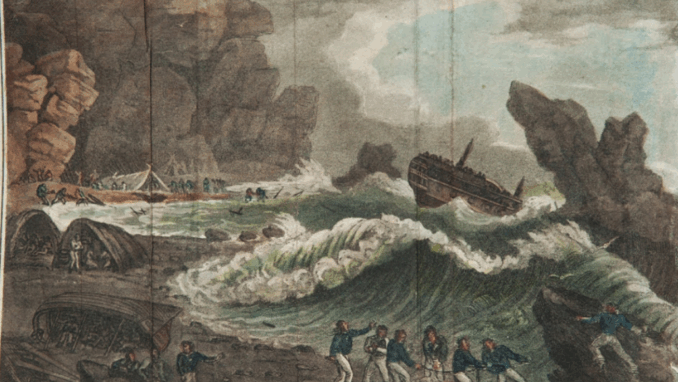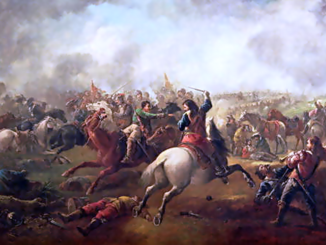
See page for author, Public domain, via Wikimedia Commons
Every so often, a book comes along which just knocks your socks off. You want to recommend it to everybody and buy it for all your friends. This is one of those!
The Wager is not, as you might at first think, about a wager. It is the story of a ship – and what a story it is. Not just the ship – but its human complement, too. ‘Each man in the squadron’, notes Grann, ‘carried, along with a sea chest, his own burdensome story’.
Adventure, history, derring-do – this tale has all of the above. But, more than anything, it’s about the triumph of the human spirit, and the astonishing nature of how much punishment the mortal body can withstand.
The central event of the book is the mutiny which took place on the Royal Navy sailing ship HMS Wager in 1741, after she was wrecked off the coast of Chile. The Wager was a sixth-rate square rigger that had previously seen service as an East Indiaman. The squadron she was part of had been despatched to South America to harass Spanish shipping during the War of Jenkins’ Ear in 1740. Jenkins, a British merchant captain, had appeared before Parliament in 1738 to claim that a Spanish officer had stormed his brig in the Caribbean, accused him of smuggling, and cut off his ear. The main counter-effort was a huge fleet of 186 ships, led by Admiral Vernon, to launch an attack on Cartagena (one of Spain’s main South American silver-shipping ports in the Caribbean). But, at the same time, Commodore George Anson was to lead a smaller clandestine operation – he had secret orders to sail round Cape Horn, across the Pacific Ocean and intercept and capture a Spanish galleon laden with treasure – later described by a participant as ‘the most desirable prize that was to be met with in any part of the globe’. Best of all, the crew were to be given shares in this prize if they were successful.
The blurb on the back sets the later scene:
‘1742: a ramshackle vessel of patched-together wood and cloth washes up on the coast of Brazil. Inside are thirty emaciated men, barely alive. Survivors from the Wager, a British vessel wrecked while on a secret mission to raid a Spanish treasure-filled galleon, they have an extraordinary take to tell.
Six months later, an even more decrepit boat comes ashore on the coast of Chile, containing just three castaways with their own, very different account of what happened. The thirty sailors who landed in Brazil, they maintain, were not heroes – they were mutineers.
As accusations of treachery and murder fly, who is telling the truth?
The stakes are life-and-death – for whoever is guilty could hang.’
The culmination of the book is a court scene worthy of a Hollywood blockbuster or a John Grisham novel. Yet, to me, this wasn’t the main interest of the book. That was the incredible tale of survival on one of the most inhospitable coasts in the world, as the men who were left behind after the shipwreck sought simply to stay alive, to keep themselves fed and sheltered and to decide whether or not it made sense to try again and again to escape with the meagrest and flimsiest of materials at their disposal. Even setting up a basic society, a functioning group, was fraught with difficulties. How to distribute food fairly? How to deal with dissenters, who risked the lives of all the others. How to take decisions … who should be in charge … all the petty jealousies and ego trips that humans are heir to tend to surface when survival is at stake, and there is no objective way of determining what should be done, or the best way of doing it. ‘ “Below forty degrees latitude, there is no law’, a sailor’s adage went. ‘Below fifty degrees, there is no God”.’
The great achievement here is that the author makes every sailor, however humble, come to life. You really feel you know these characters, with all their various foibles and personalities. Glamorous, of course, it was not. Those from an upper crust background fared little better. ‘ “Ye gods, what a difference!” one such midshipman recalled. “I had expected a kind of elegant house with guns in the windows; an orderly set of men; in short, I expected to find a species of Grosvenor Palace, floating around like Noah’s Ark.” Instead, he noted, the deck was “dirty, slippery and wet; the smells abominable; the whole sight disgusting; and when I remarked the slovenly attire of the midshipmen, dressed in shabby round jackets, glazed hats, no gloves, and some without shoes, I forgot all the glory … and for nearly the first time in my life, and I wish I could say it was the last, took the handkerchief from my pocket, covered my face, and cried like the child I was.” ‘
Grann’s writing is clear and original, but never makes the mistake so many authors striving for originality make – that of becoming obscure or pretentious. He simply illuminates things in a fresh way. Take the opening sentences, for example: ‘The only impartial witness was the sun. For days, it watched as the strange object heaved itself up and down in the ocean, tossed mercilessly by the wind and the waves’. How could you not want to read on?
The tale of the Wager is not new, but this treatment of it certainly is. Another meticulously-researched work from David Grann, The Wager became a number one international bestseller. It ‘unfurls like a great sail’, as the Guardian’s reviewer put it.
Never give up. That is the message I took from this narrative.
© foxoles 2025



